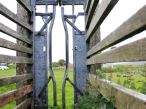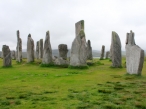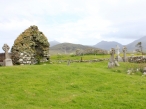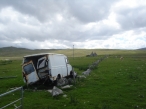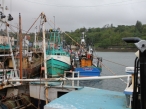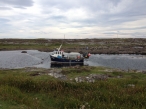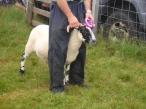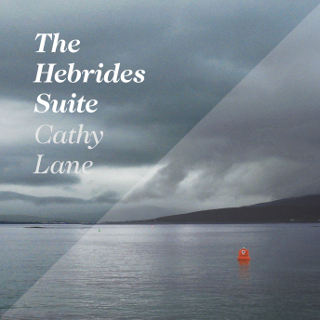
The Hebrides Suite | Cathy Lane
Gruen 127 | Audio CD > [order]
Reviews
How does history – past lives and past events- leave sonic traces and how can we hear them?
The Hebrides Suite is the result of an attempt to answer this question and the culmination of composer Cathy Lane’s three decade long engagement with the Outer Hebrides.
The Outer Hebrides form a 130-mile long archipelago about 40 miles off the north-west coast of Scotland. There are more than 200 islands but only a few are now inhabited. In the 2001 census the total population of the islands was 26,502. The best known of these islands are Barra (1078), Benbecula (1219), Berneray (136), North (1271), South Uist (1818) and Harris and Lewis (combined population 19,918). There has been an overall slow population decline in the islands over the last two hundred years, with peaks and troughs caused by economic and political fluctuations. In the 1840s poverty and famine lead to whole villages being evicted by landowners, often brutally, to make way for the higher profits of sheep farming. During these forced clearances many people took assisted passages to Canada and Australia and as far away as Patagonia and the Falkland Islands. In the twentieth and twenty first centuries much of the island lands are still owned by absentee landlords and the islanders‘ struggles for self determination and economic and political control have continued.
The Outer Hebrides are the most strongly coherent Scottish Gaelic (Gàidhlig) speaking area in the world. Gaelic is a Celtic language related to Welsh, Cornish and Breton. In 2001, 61.1% of the population of the Outer Hebrides spoke Gaelic (compared with 1.2% in the whole of Scotland). A handful of Gaelic speakers can be found in the United States, Canada and Australia most of whom are descended from nineteenth century emigrants. There is a strong Gaelic culture.
Religion is also a significant factor in the life of the inhabitants of the islands. The southern islands of Benbecula, South Uist and Barra are predominantly Roman Catholic. In the northern islands, especially Harris and Lewis, the non-conformist Free Church of Scotland and the still more conservative Free Presbyterian Church of Scotland are very influential. There is a tradition of Sabbath observance and few shops or transport services are available on Sunday although this is increasingly contested.
The emigration still continues, particularly among the young, as the islands offer few employment opportunities. Most present day commercial activities concern tourism, including heritage tourism; crofting; fishing and fish farming and weaving including the manufacture of Harris tweed, a cloth that has been handwoven by the islanders in their homes using pure virgin wool that has been dyed and spun in the Outer Hebrides.
Each of the works in The Hebrides Suite uses a mixture of field recordings, interviews and oral history material from existing archives to explore aspects of island life past and present through the medium of composed sound.
Tracklist
1. Sea Shanty 8’13”
MP3
2. On the Machair 10’03”
3. Tweed 11’00”
MP3
4. Gaoth (Wind) 9’59”
5. Where Once Were Whales 12’02”
MP3
6. Watch Over Us All 12’00”
MP3
6 Tracks (60′52″)
CD (500 copies)
Credits and Thanks
I am grateful for many collections and materials especially:
Sound Archive, School of Scottish Studies, Edinburgh.
Photographic Archive, School of Scottish Studies, Edinburgh (particularly for photographs by Werner Kissling, Paul Strand and Gus Wylie).
The Scottish Collection at Edinburgh City Library.
The Scottish Life Archive, National Museum of Scotland, Edinburgh.
Stornoway Museum, Stornoway, Lewis.
Communn Eachdradh, (Ness Heritage Centre) Ness, Lewis.
Taigh Chearsabhagh, Lochmaddy, North Uist.
Kildonan Museum, South Uist.
And to many fascinating publications old and new.
Thanks to:
Dr Cathlin Macaulay, Alison Brown, Mairi MacKenzie, Caitriona MacCuish, Catherine Campbell, Donald Macsween, John and Mary Maclean, Rev. Iver Martin and the congregation of the Free Church of Scotland, Stornoway, Rev C. I. Macleod and the congregation of the Free Church of Scotland, Back, Lewis, many unnamed helpers and informants and London College of Communication, University of the Arts London.
All photographs by Cathy Lane and Polly Bagnall
Artwork by FLATLAB and Polly Bagnall
Soundscape Series by Gruenrekorder
Germany / 2013 / Gruen 127 / LC 09488 / PRS / EAN: 4050486106921
PROGRESS REPORT
I know nada about this composer, but The Hebrides Suite gathers six pieces borne of her heavily pronounced love affair with The Outer Hebrides. Gathering a wide range of field recordings and spoken dialogue from these islands, Cathy Lane aims to evoke sonic traces left by their rich history. Considering the tools at work here, this might seem like a tough call but via a series of occasionally looped voices from locals recounting their personal stories, bleating sheep, rhythmic machine clanking, lapping waves, singing churchgoers, the sounds of nature, tempered engine rumbles, melodic traces and indiscernible fluttering and rasping sounds, everything falls together perfectly. At once sentimental and celebrating life as it presently stands on the islands, The Hebrides Suite, replete with the enchanting photos adorning both the cover and the booklet inside, pays perfect testament to the magic, wonder and beauty of them.
Highly accomplished, this makes for a very rewarding listen. RJ
link
IDWAL FISHER – an antimacassar for the hearing
[…] You’d think that Cathy Lane’s homage to those far flung Scottish islands the Outer Hebrides would be a bleak affair full of uilleann pipes and the pounding of waves onto stout harbour walls. Its anything but. What begins with the warning bleeper of a docking ferry soon unravels into a series of interviews where voices are looped, some being given various ‘treatments’, before being mixed with the sounds of birds, sheep, tweed looms, the ever present winds, the crashing waves and in the last track and most memorably a church service where the congregation sing a mournful psalm to the sound of yet more crashing waves.
Lane’s aim is to heighten awareness of these islands, its culture, its natural history and local history. But it was only during ‘Watch Over Us All’ the strongest track amongst the six here, with its layered plaintive singing and austere sermon that I found myself finally rapt. The Whicker Man loomed large for me albeit in a Calvinist/Presbyterian/Protestant/Catholic/Free Church of Scotland non pagan kind of way.
Mosaïque Mosaic actually begins with a church service. They’re praying to the same God but that straight laced fear of God Scottish hell fire and brimstone service has been replaced by a shoulder swaying, keyboard swirling one where the sermon is delivered twice, once in French and once in English: My God! Mon Dieu!. […]
link
Holger Adam | testcard #24: Bug Report. Digital war besser
[…] Weit vor der Küste Schottlands liegen die Äußeren Hebriden, wo CATHY LANE The Hebrides Suite aufgenommen hat, und sogleich stellt sich die nächste Frage: Wird mir kalt, wenn ich Aufnahmen aus einer Gegend höre, in der das ganze Jahr über eher niedrige Temperaturen herrschen? Nach einer Decke zu fragen fiele mir schwer, denn die schottisch-gälische Sprache der Bewohner_innen der Inseln, die ebenfalls Teil der Aufnahmen ist, ist nicht ganz so leicht verständlich. Aber man würde ja bemerken, dass mich fröstelt, oder? Daher nichts wie raus aus dem nass-kalten Klima und ab in den Süden auf die Kleinen Antillen, und schon wärmt mich der Sound der Tropenvögel, die nachts aus dem Dschungel heraus vernehmbar sind. Ein wenig gruselt mich der Gedanke an das dunkel-grüne Dickicht allerdings auch. Daran ist natürlich nicht der Dschungel sondern mein durch Kulturindustrie verbildetes Bewusstsein schuld, drängt sich mir doch Werner Herzog mit seiner Rede über die Obszönität des Dschungels ins Ohr. […]
link
Ed Pinsent | The Sound Projector
Happiness in the Homeland
[…] The Hebrides Suite (GRUENREKORDER GRUEN 127) from composer and sound artist Cathy Lane is head and shoulders above most average field recordings…she’s very good at editing and arranging her materials, not afraid to let things overlap…we don’t get a rush of information, but just the right amount of it, in order to reveal the truth of the place she’s trying to document. It’s almost like impressionist painting, done on tape. I think this is how she approaches most of her projects, and she always has a strong connection to the environment in question. This comes across very clearly on these Hebrides recordings; she says the “compositions…have grown out of a long standing love affair with the landscape and the people there.” Although the actual source material may seem mundane if we trot it out like a shopping list – wind, weather, rain, oceans, local wildlife, church bells, ferries, and people talking about their work as crofters or fishermen – the cumulative effect is very touching and deep, presenting a truly vivid and resonant documentary through these overlapping and fading sounds. What’s best of all is that it’s totally free from “editorialising”, which is what would happen if someone from the BBC ever got their hands on the project. The work is complemented by a booklet of full colour photos and notes from the artist. I’m beginning to think Gruenrekorder are currently presenting some of the best statements in the “genre” of field recording today.
link
Stephan Roiss | freiStil – Magazin für Musik und Umgebung #54
Drei jüngere Releases aus dem Hause Gruenrekorder porträtieren mittels field recordings unterschiedliche Ecken der Welt: Cathy Lane hat unter dem Titel the hebrides suite eine Liebeserklärung an die Hebriden abgegeben. Diese Gruppe von mehreren hundert Inseln nordwestlich des schottischen Festlands ist spärlich besiedelt, das Hörstück dementsprechend mit Beschaulichkeit angereichert. Der Auftakt-Track führt jedoch sogleich produktiv in die Irre und nimmt zugleich allen, die Kitsch von diesem Tonträger befürchten, mit eindrucksvoll kompiliertem Krach die Angst: schrille Alarmsignale, Bau- und Verkehrslärm, Lautsprecherdurchsagen einer Schiffcrew. Was dann folgt, liegt freilich über weite Strecken fernab der Industrie und der Welt der Technik, gibt sich vielmehr herzlich und spektakulär unspektaktulär. Das Stück führt in Ställe, Kettenrasseln, Hufschlag, auf Wiesen voller Schafe, immer wieder ans plätschernde, glucksende, rauschende Meer, folgt der Musik ins Innere eines Pubs. Auf derlei Soundflächen legen sich menschliche Sprachfetzen, Auszüge aus Unterredungen, die inhaltlich – mal lose, mal direkt – mit den Geräuschen korrespondieren und dabei die Geschichte und Gegenwart des Insellebens ausloten. Die Worte sind bisweilen in schottisch-gälischem Slang gehalten, wodurch für die meisten HörerInnen aus dem deutschsprachigen Raum manches schwer zu erschließen ist. Cathy Lane hat die ineinander greifenden Stimmen raffiniert bearbeitet, entrückt, geloopt und dort maßvoll effektiert, wo es zuträglich erschien. The Hebrides Suite hallt allmählich aus mit überlagerten, subtil dekonstruierten Kirchengesängen. Das letzte Wort sprechen aber die Ruhe am Strand, die Möwen und die Wellen. […]
Salomé Voegelin | The Wire Magazine – Issue 361
With this album, released in Gruenrekorder’s Soundscape Series, Cathy Lane declares her longstanding love affair with the Outer Hebrides. She does so without simplifying phonography into the trope of the solitary wanderer, microphone in hand, staring at the might and magnitude of nature while remaining apart. On the contrary, while there is space in all six tracks to be alone with nature, this nature is not at a distance, but inhabited and lived – raw and harsh rhythms of weather meet those of language and bodies to produce memories in the present, spun from the pulse of life, death and the struggle for survival. No more so than in “Tweed”, where the body of the listener is drawn into the rhythm of work and voices, and the textures of tweed are spun from the sound of their own manufacture. This track also featured in a recent Crafts Council exhibition that toured between Scotland and the South East of England, a context that amplified the connection between the rhythm of work and the rhythm of music largely lost in a post-industrial society and abandoned in the cerebral processes of electroacoustic composition. The best track, “Where Once Were Whales”, creates a powerful juncture between the actual location and its musical construction. Voices from oral history archives and those recorded by Lane talk about fishing and seafood, narrating the place through lost traditions and current customs, while compositional strategies play and expand those voices as sounds into the acoustic environment. This composed piece represents not a geographical actuality but invites an individual imagination triggered by clicks, ticks and waves of water that reverberate with and through the words. Lane’s precise digital processing of environmental sounds and voices does not overpower the recordings but shapes them beyond the phonographic field into a composition that is at once a document and the site of production – it generates facts and music that invent rather than confirm their origin and discipline. The electronic manipulations respond to the recordings, garnering their tonalities and augmenting their rhythms, rather than embellishing them. Lane first visited the Hebrides in the late 1970s. With this current album she leads the way towards a new relationship between field recording and electroacoustic composition, inadvertently critiquing the approach of sticking your microphone into the field while also unpacking an electroacoustic vocabulary.
Tina Manske | Musikmag
Über Geschichte
Apropos Vergangenheit: für „The Hebrides Suite“ unternahm Cathy Lane einen Ausflug auf die Äußeren Hebriden, eine Inselgruppe von mehr als 100 Inseln 40 Meilen westlich von Schottland. Aus ihren dort gewonnenen Feldaufnahmen, Interviews mit den dort lebenden Menschen und Aufnahmen aus schottischen Archiven komponiert Lane eine Mixtur, die das Verschmelzen von Vergangenheit und Gegenwart möglich macht.
„Ich wollte erfahren, ob Geschichte, vergangene Leben und vergangene Geschehnisse akustische Spuren hinterlassen“, sagt Lane. Jedes ihrer Stücke dreht sich dabei um einen bestimmten Aspekt des Insellebens, sei es die Schafzucht, die Schifferei, Religion oder der Wind. So unternimmt Lane einen interessanten Versuch, sich einer Region in 360 Grad über ihre Geschichte zu nähern.
link
Cheryl Tipp | The Field Reporter
‘The Hebrides Suite’ is a multi-layered collection of composed works that reflect Cathy Lane’s ongoing fascination with the Outer Hebrides. A mixture of field recordings, audio diaries, conversations, interviews and oral histories drawn from archives across Scotland, these six pieces explore the history, traditions and ways of life of these ancient islands.
How does history – past lives and past events – leave sonic traces and how do we hear them?
Each piece is based around a particular theme pertinent to island life, be that weaving, local transportation, crofting or religion. All are complex patchworks of sound that have the power to take your breath away. Each one a fascinating vignette that encapsulates its subject in an engaging, imaginative and sophisticated manner. The multifaceted nature of these compositions creates an intensity that is almost tangible, demonstrating once again the power of sound to evoke a feeling or induce a reaction.
‘Tweed’ is a captivating interpretation of the weaving industry of the Outer Hebrides. The clatter and hum of machinery is embellished with disembodied voices that develop their own rhythms, akin to the lyrical nature of the looms used to produce this famous cloth.
The only piece not to feature any spoken word is ‘Gaoth (Wind)’. It’s a beautiful homage to the ever present wind and coming in at the middle of the CD, creates an effective natural break between the more intensive arrangements before and after.
‘Watch Over Us All’ is a sombre conclusion to the suite, acknowledging the central role religion still plays in the lives of the island inhabitants. Community is everything here and the church is at the heart of this. As the singing and the sermon gradually fade, the delicate song of a Skylark takes centre stage, pointing towards the rich biodiversity that exists here.
A huge amount of time, thought, emotion and effort has gone into ‘The Hebrides Suite’. Each work is wonderfully intricate, comprising snippets of recordings that must have been painstakingly researched, collected, analysed and brought together. It demands and deserves attention.
‘In 2006, I sat looking through the misty soft rain towards the ruined chimney and listened to a ship motoring into the sea loch below, almost right up to the whaling station, lifting lobster pots. A little further up the road is the spot where on two separate cycle tours from the south to the north of the Outer Hebrides I was defeated by a mixture of horizontal rain and a ferocious headwind and gratefully turned around and headed back towards Tarbert and the gentler south. On one of those journeys I remember the sound of a weaving loom from inside a shed as we passed it on the road.’ -Cathy Lane
link
Richard Allen | a closer listen
Forty miles off the coast of Scotland lie the Outer Hebrides, an archipelago of islands whose populace have seen some harsh times yet still endure. Over the past three decades, Cathy Lane has enjoyed a love affair with the archipelago. The Hebrides Suite is her sonic love letter to the land and people.
As a mixture of field recordings and interviews, the album has the feel of a television show without the sound. Soon one begins to realize that the images are conjured in the mind, and perhaps appreciates the old radio shows a bit better. Those shows captured the imagination and inspired generations to picture their own images. While it helps to have the physical edition (with beautiful, extensive liner notes), it’s fascinating to simply listen and to be awash in sounds. Awash is the key word, as the ocean is never far from the foreground. Sea salt runs through the residents’ veins.
transportThanks to air travel, the journey to the Hebrides is easier now than ever, but the traditional ferry still offers the most authentic experience. Lane writes that “the sound of the announcements, the throb of the engine and the strain of ropes, the clang and scrape of the heavy metal ramp on the port as well as the culinary joys of a macaroni cheese pie are familiar to any traveler to the islands” (abbreviated). These sounds are captured in brilliant stereo for the home listener. Unfortunately, due to packaging challenges, no macaroni pie is included with the recording.
Less cheerful is the recounting of a historical eviction, as profits dictated the displacement of people in favor of sheep. The event may have occurred in 1849, but it still stings. Even a snatch of accordion recorded at a birthday party can’t undercut the sense of melancholy. As words tumble in the tide, a dog barks, sheep bleat and metal gates crash. The layered effect is disorienting, as if past, present and future were colliding in a wormhole. Looped dialogue lends the collage a world-weary tone. And more, and more, and more. And yet the crofters and weavers display an intense pride in explaining their work.
ChurchAs fascinating as the dialogue samples may be, one longs to hear more of the Hebrides itself, and Lane accommodates this need in the second half of the recording. ”Gaoth (Wind)” is particularly effective, a study in the effects of wind in various locales from beach to pen. In the liner notes, one learns about the local opposition to a wind farm (36 turbines were eventually installed, instead of 181), but the sound of the wind tells a better story. In “Watch Over Us All”, Lane captures the sound of Sunday morning worship, but as she writes, “the skylarks singing above the ruined 13th century church get the last word”. The suite ends with the Hebrides itself, reminding us that the islands existed before us and will likely outlast us as well.
link
Guillermo Escudero | Loop
The sound artist, composer, lecturer and researcher Cathy Lane, lives and works in London. She’s Professor of Sound Arts, University of Arts London and co-directs the Sounds Creative Arts Research Practice (CRiSAP).
Cathy Lane is interested in how sound relates to the past, our stories, the environment and our collective and individual memories. In this context, she wonders how history, past lives and past events leave traces of sound and how we hear them.
The press release states that ‚The Hebrides Suite‘ is an attempt to answer this question and is the culmination of three decades involved with the Outer Hebrides by Cathy Lane that form a 130-mile long archipelago and about 40 miles off the northwest coast of Scotland.
This album consists of six tracks of one hour approximately and starts with ‚Sea Shanty‘, a ferry ride to the Outer Hebrides where we can hear the engine noise, children, adults talking and announcements in English and Gaelic. ‚On the Machair‘ it can be appreciate people talking in Gaelic and English about the life system consisting of small farms which produce small amounts of food, fishing and animal husbandry, mainly sheep. Machair is a Gaelic word that means a vast plain formed of shell sand. Very few people lives in these places. ‘Tweed’ reflects the importance that sheep has been for this land. The Harris Tweed industry has developed traditional clothing that farmers do by hand and it can be listen to a woman weaving manually. ‚Gaoth (Wind)‘. The wind is ever present in the Outer Hebrides. There was a project to install windmills but it was rejected by the Scottish government. Nowadays every inhabited run their own wind turbines. On ‚Where Once Were Whales‘ certainly we can listen to the sea and deep into the island there are the last vestiges of the wailing industry. The main local fish catches are lobster, crab and shellfish that are sold to foreign markets. On ‚Watch Over Us All‘ it can be listen to locals walking in the streets of Stornoway to the Free Church of Scotland. It’s Sunday and almost everything is closed.
For the reviewer has been very interesting to know the life and wildlife of the Outer Hebrides – distant and mysterious land – through sound.
Le Son du Grisli
Cathy Lane est partie à la recherche des traces sonores (je cite) que l’histoire a laissées sur les îles Hébrides, au large de l’Ecosse. Au milieu des bêlements, des bruits de pas et de moteurs, on découvre sur le CD de nombreux témoignages d’habitants qui peuvent parler en même temps ou que Lane peut transformer en les copiant et collant pour en faire de drôles de loops (là on est à la frontière de la « réalité augmentée »). Impossible de suivre toutes les nuances de la langue et de l’accent… il faut alors se raccrocher aux rythmes de ce document qui en devient poétique. (pc)
Jack Chuter | ATTN:Magazine
A distinct and resonant collage of the Outer Hebrides, just off the Scottish mainland.
The sounds opening The Hebrides Suite are instantly familiar: the wind that wraps round my head like a sandpaper scarf, the metronomic warning beeps and electronic whirrs of ferry mechanism, the tinny and half-croaked tannoy announcement that cuts the ribbon on my overseas journey and verbally unravels the path ahead. Lane captures the very deliberate and considered nature of travelling by ferry – the vehicle itself is constantly emitting a symphony of siren and water collision, proclaiming the act of transport over and over again. It carries its own distinct acoustic flavour; a cold echo curls up in amongst the slanted metal panels and painted bolts and leaps back out into the cabin, cradling each word in a pocket of rust and salted air.
A couple of times a year my girlfriend and I trek from Bournemouth in Southern England to the Isle Of Mull in the Inner Hebrides, where her parents live in a gorgeous house just up from Tobermory high street. Like Cathy, our expedition concludes with a ferry trip from the Scottish port town of Oban. It’s a journey of stages: of distinct arrival and departure through various modes of public transport, with each phase accompanied further alterations of the existing landscape (slight drops in temperature, a notable increase in greenery). By the time we arrive on Mull we feel utterly disconnected from the reality from which we came; separated from home by a series of stops and rituals, like a boat forced to pass through a multitude of locks.
The echo of mainland interests and tradition doesn’t resound here. Lane generates rhythm and fluidity from interview clips in Gaelic and English, concerning land structure, natural process and vegetable growth; concerns that seem immune to erosion, as if time loops back in on itself each day. Meanwhile, a coarse surge of wind and seawater over sand laps up against the ears – a constant, respiratory soundtrack, into which a choir of sheep and the odd rumble of motor engine (a notably low frequency sound in a chorus that tends to hug the middle to upper ranges) become organically embedded.
One of my favourite sounds on the record is an old Hattersley loom that reprises throughout “Tweed” – a beautiful, hand-cranked cascade through which loose chains and metal cogs rattle and shake. Lane uses it as the basis to coax rhythm out of language; words are skipped and delayed into tiny gallops of Gaelic phoneme, mimicking an uneven machinery mechanism, overlapping with other conversational extracts that swirl and grind across eachother; the Hebrides becomes its own machine of circadian process, interlocking into a water-tight weave of rugged landscape and uneroded tradition.
Frans de Waard | VITAL WEEKLY
[…] We cross the Atlantic again but go north, to the Outer Hebrides, a remote ‚130 mile long archipelago of islands about 40 miles off the north-west coast of Scotland‘. Gruenrekorder has the previous two as part of their field recordings series, this one is in the ’soundscape series‘, so I assume that the material is not presented ‚as is‘, but is used to compose a piece of music with this, with repeating blocks of sounds, mixes of various bits together, but with the overall idea that we stay in one place and we know more of the place. Cathy Lane does that in six pieces, all around nine to twelve minutes and each is about a certain aspect of the Hebrides, the wind, the sheep/the mill, life on the islands and such like. Sometimes, such as in ‚Where Once Were Whales‘, about fishing, we also hear voices, talking about their trade, even when it’s not always to understand what they are telling us, partly due to the dialect, partly due to the fact that the voices are layered. It perhaps adds to the mystique of the release? Unlike the other two, which are ‚merely‘ audio travelogues, Lane actually composes with the material and makes some very strong compositions with it. Of the three releases, it’s also the one which has the most documentation, explaining in detail what each piece is about. I quite enjoyed all three of these releases, but it was the Cathy Lane release that I especially enjoyed for it’s more musical qualities. One to play again and again. (FdW)
link
Cathy Lane | The Hebrides Suite
@ KNITSONIK 05 podcast – Sitting by the fire, Dreaming of the sea…




